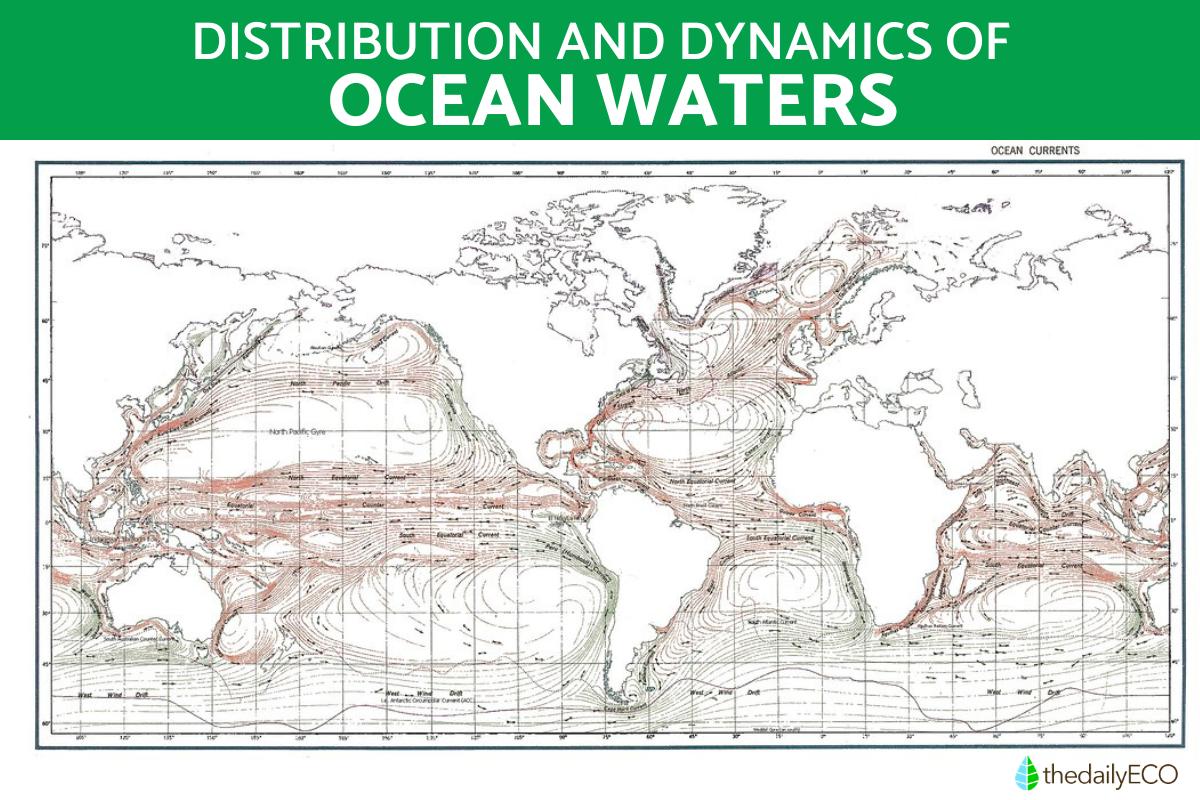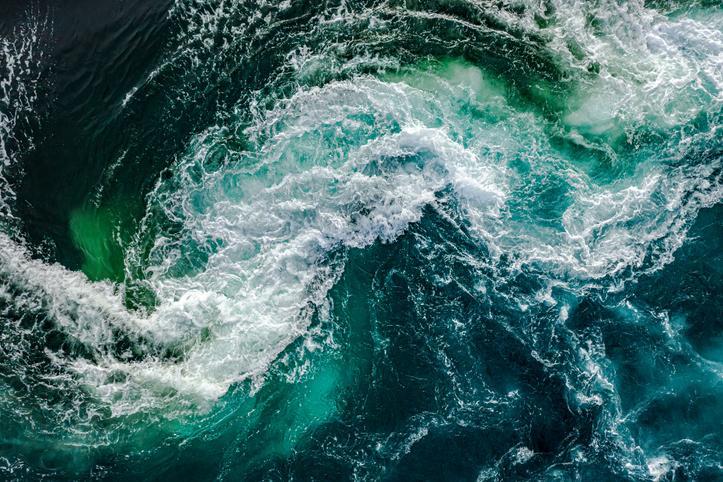What Are Sea Waters or Ocean Waters?


Sea waters, also known as ocean waters, encompass the vast bodies of saltwater found on Earth. They are a significant component of the hydrosphere, comprising about 97% of the planet's water. The distribution of ocean waters is extensive, covering approximately 70.8% of the Earth's surface. These expansive aquatic ecosystems play a crucial role in shaping global climate patterns, supporting diverse marine life, and serving as a vital resource for human civilization.
In this article from thedailyECO, we will delve into the definition, distribution, and importance of sea waters, exploring their characteristics and the fundamental role they play in sustaining life on our planet.
What are sea waters or ocean waters?
Sea waters or ocean waters refer to the vast bodies of saltwater that cover a significant portion of the Earth's surface. They are composed of water that fills the major interconnected basins known as oceans, as well as the smaller enclosed bodies of water called seas.
Ocean water covers approximately 70.8% of the Earth's surface, making it the largest continuous body of water on the planet. This vast expanse of oceanic waters holds about 97% of all the water on Earth. The remaining 2.5% is freshwater, primarily found in ice caps, glaciers, groundwater, lakes, and rivers.
Ocean waters are characterized by their high salinity, primarily due to the presence of dissolved salts. The primary salts found in ocean waters are chloride (Cl-) and sodium (Na+), which are predominantly derived from the weathering of rocks and the transport of minerals by rivers and other water sources. The salinity of ocean waters varies depending on factors such as evaporation, precipitation, and inflow of freshwater from rivers and melting ice.
The ocean is a vital component of the Earth's hydrosphere, which encompasses all water on our planet. It plays a fundamental role in supporting and sustaining life on Earth.
What is the difference between oceans and seas?
The terms "ocean" and "sea" are used to describe the vast bodies of saltwater that cover the Earth's surface. In general, the terms "ocean" and "sea" can be used interchangeably. However, technically, a "sea" is a body of water that is partially or entirely enclosed by land, typically considered as a division of the world ocean. The term "sea" can also be used for smaller bodies of seawater, such as the North Sea or the Red Sea.
While there is no distinct boundary between seas and oceans, seas are generally smaller and often have partial land borders (referred to as marginal seas) or complete land borders (referred to as inland seas).
What makes ocean water blue?
The blue color of ocean water is the result of sunlight absorption and scattering. Sunlight consists of different colors, and when it enters the ocean, water molecules selectively absorb longer-wavelength colors like red and orange, while blue is absorbed to a lesser extent.
The remaining blue light is scattered by water molecules and particles in the ocean, with blue light being scattered more efficiently due to its shorter wavelength. This scattered and reflected blue light contributes to the overall perception of the ocean's blue color. Factors such as water depth, suspended particles, and sunlight angle can affect the shade of blue or even other colors in different locations.
Do not miss this other article where we explain what an aquatic ecosystem is, its characteristics, types, flora, and fauna.

Distribution of ocean waters
The oceans are divided into five main basins: the Pacific Ocean, Atlantic Ocean, Indian Ocean, Southern Ocean (also known as the Antarctic Ocean), and Arctic Ocean. Here are some key points regarding the distribution of ocean waters:
- Pacific Ocean: the Pacific Ocean is the largest and deepest ocean, covering approximately one-third of the Earth's surface. It extends from the Arctic in the north to the Southern Ocean in the south and is bordered by the Americas and Asia.
- Atlantic Ocean: the Atlantic Ocean is the second-largest ocean, separating the Americas in the west from Europe and Africa in the east. It stretches from the Arctic in the north to the Southern Ocean in the south.
- Indian Ocean: the Indian Ocean is the third-largest ocean, located between Africa, Asia, and Australia. It extends from the Southern Ocean in the south to the Arabian Sea and Bay of Bengal in the north.
- Southern Ocean: the Southern Ocean surrounds Antarctica and is sometimes considered as a separate oceanic region. It is characterized by its strong circumpolar current and is home to diverse marine life, including seals, whales, and penguins.
- Arctic Ocean: the Arctic Ocean is the smallest and shallowest of the five oceans, situated around the North Pole. It is mostly covered by ice throughout the year, with seasonal variations. The Arctic Ocean plays a crucial role in regulating global climate and is experiencing the impacts of climate change, including diminishing sea ice.
In addition to the oceans, there are numerous seas that are more enclosed and less extensive than oceans. The International Hydrographic Organization recognizes around 60 major seas, including the Mediterranean Sea, Caribbean Sea, Black Sea, Baltic Sea, and Red Sea, among others.
It is important to note that the distribution of ocean waters is not equal in both hemispheres. The Southern Hemisphere has a higher ratio of water to land compared to the Northern Hemisphere. This disparity influences climate patterns and other environmental factors.
If you're curious about climate and its various types, we have another article that delves into this topic.
What is ocean dynamics?
Ocean dynamics is a fascinating field that investigates the various movements and pathways of ocean water, as well as their influence on the surrounding terrain. In this section, we will explore how the dynamics of oceanic waters are generated and discuss the three primary types of movements they exhibit, each with its own distinct characteristics.
Waves
Waves are created by the force of the wind acting upon the water's surface. This interaction causes the water to move in a cylindrical shape. As waves approach the coast and reach shallower depths, the imbalance in the mass of water leads to the breaking of the wave.
It is important to note that tsunamis, which are colossal waves, can also occur due to volcanic eruptions or earthquakes on the seabed. Tsunamis differ from regular waves in terms of their size and the underlying causes that generate them.
Tides
Tides are the result of the gravitational forces exerted by the Moon and the Sun on the Earth. These forces create periodic rises and falls in sea level, typically occurring approximately every six hours. During high tide, the sea level rises, while during low tide, the sea level recedes. Tides play a crucial role in coastal ecosystems and have a significant impact on navigation and coastal activities.
Ocean currents
Ocean currents can be generated by various factors. Differences in salinity and temperature between bodies of water can create deep ocean currents, also known as thermohaline currents.
Additionally, ocean currents can be influenced by winds, the rotation of the Earth, and the presence of landmasses. Surface ocean currents, for instance, are often driven by wind patterns and are influenced by coastal boundaries. The cover image of this article displays a map showcasing both warm and cold marine and ocean currents.
The interplay between waves, tides, and currents shapes coastal landscapes, affects marine ecosystems, and has implications for various industries such as shipping, fishing, and marine conservation.
We highly recommend watching the video below, which provides a detailed explanation of how tsunamis are formed.

Importance of ocean waters
The movements of oceanic waters hold significant importance due to their diverse impacts on various aspects of our planet and society.
- Erosion and material transport: the movements of oceanic waters contribute to the erosion and transport of materials along coastlines. This process shapes and forms different types of coastal ecosystems, such as beaches, marshes, and tidal flats. These ecosystems provide habitats for a wide range of marine organisms and support rich biodiversity.
- Nutrient Transport: oceanic water movements play a crucial role in the transport of nutrients. Nutrients are essential for the growth and development of marine populations and communities, including animals and plants in coastal ecosystems. The movement of ocean currents facilitates the distribution of these nutrients, supporting the productivity and sustainability of marine life.
- Thermoregulation: ocean currents have a significant impact on the thermoregulation of the planet. They transport heat from the Earth's equator to the poles, helping to distribute and regulate temperature differences between different regions. This process plays a vital role in maintaining global climate patterns and mitigating extreme temperature variations.
- Connectivity and trade: the interconnected nature of oceanic water masses serves as a vital link between countries and continents. Ocean currents and movements facilitate travel, trade, and transportation of goods across the globe. They enable connections and interactions between nations, contributing to cultural exchange, economic activities, and the well-being of societies.
- Natural Resources: the oceans are abundant in natural resources that are vital for human development. They provide a vast reservoir of resources such as fish, minerals, oil, and gas. The movements of oceanic waters influence the distribution and accessibility of these resources, impacting industries such as fishing, energy, and mining.
Understanding and appreciating the importance of oceanic water movements helps us recognize the profound influence they have on Earth's ecosystems, climate regulation, global connectivity, and the availability of valuable resources. It highlights the necessity of responsible stewardship and conservation efforts to ensure the sustainability and preservation of our oceans for future generations.
You might be interested in the following article, where we discuss the causes, consequences, and solutions to plastic pollution in the oceans.
If you want to read similar articles to What Are Sea Waters or Ocean Waters?, we recommend you visit our Environment (other) category.






